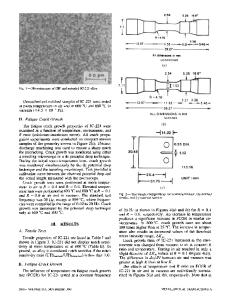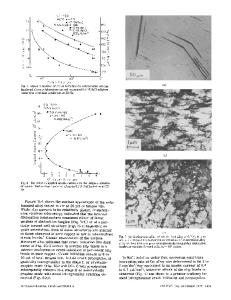Temperature and strain-rate effects on low-cycle fatigue behavior of alloy 800H
- PDF / 5,118,162 Bytes
- 13 Pages / 597.28 x 777.28 pts Page_size
- 20 Downloads / 312 Views
INTRODUCTION
A L L O Y 800H is an iron-based, fully austenitic alloy. It has the same chemical composition as alloy 800 with the exception that the carbon content is restricted to the upper portion of the standard range for alloy 800. In addition to a controlled-carbon content, alloy 800H receives an annealing treatment that produces a coarse grain size. The larger grain size and carbon content give this alloy greater creep and rupture strength. The alloy is used as a material for heat-exchanging components in various energy conversion systems and in the petrochemical industry. Resistance to low-cycle fatigue (LCF) and creep-fatigue interaction is an important requirement for the successful design of hightemperature, heat-exchanging components. Low-cycle fatigue loadings are expected to result from thermally induced strain cycles associated with start-up and shutdown and fluctuations in operating conditions. Only limited LCF data are available on alloy 800H at temperatures higher than 750 ~ and at strain rates less than 4 • 10-4 s-l. [1,2,3]The majority of the reported tests have been conducted at e ~- 10 -3 s-L This strain rate is orders of magnitude higher than the thermally induced strain rates (~-10 -6 s-l) in heat-exchanging components. There is, therefore, a need for fatigue data at lower strain rates in this high-temperature regime. Here, the fatigue behavior can be affected significantly because of changes in deformation and damage mechanisms caused by differences in slip mode, oxidation, phase and geometrical instabilities, and dynamic strain aging (DSA). The effect of these temperature- and time-dependent processes may reduce an alloy's cyclic life resistance by orders of magnitude as compared to the room-temperature behavior. By studying the failure modes under carefully chosen lab-
K. BHANU SANKARA RAO, on leave from the Indira Gandhi Centre for Atomic Research, Kalpakkam 603102, India, is National Research Council Fellow, NASA Lewis Research Center. H. SCHIFFERS, Head, Mechanical Testing Laboratory, and H. SCHUSTER, Section Head, Mechanical Properties and Corrosion, are with the Institute for Materials in Energy Systems, Juetich I)-52428, Germany. G.R. HALFORD, Senior Scientific Technologist, is with the Structures Division, NASA Lewis Research Center, Cleveland, OH 44135. Manuscript submitted November 17, 1994. METALLURGICALAND MATERIALSTRANSACTIONS A
oratory conditions, it is possible to obtain deeper insight into the various time-dependent damage processes, their interactions, and the factors controlling their rates of development. More confident extrapolation to the conditions that are not covered by testing should then be possible by employing appropriate life prediction approaches. The current investigation has been conducted with the following objectives: (a) to study the influence of various time-dependent processes on LCF life and cyclic stress response of alloy 800H over a range of strain rates at a relatively high temperature of 850 ~ (b) to assess the effects of temperature on LCF behavi
Data Loading...











